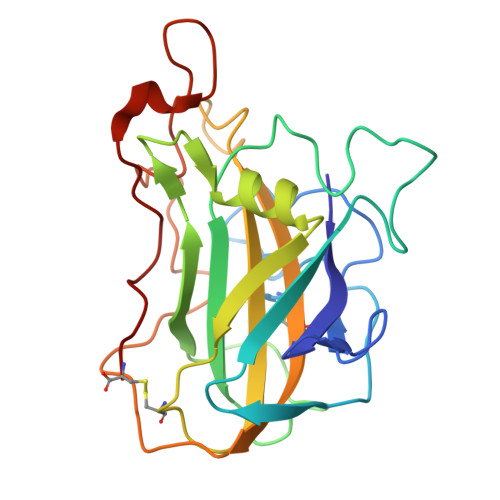Second-Sphere Histidine Catalytic Function in a Fungal Polysaccharide Monooxygenase.
Batka, A.E., Thomas, W.C., Tudorica, D.A., Sayler, R.I., Marletta, M.A.(2024) Biochemistry 63: 3136-3146
- PubMed: 39563485
- DOI: https://doi.org/10.1021/acs.biochem.4c00527
- Primary Citation of Related Structures:
9D0Z - PubMed Abstract:
Fungal polysaccharide monooxygenases (PMOs) oxidatively degrade cellulose and other carbohydrate polymers via a mononuclear copper active site using either O 2 or H 2 O 2 as a cosubstrate. Cellulose-active fungal PMOs in the auxiliary activity 9 (AA9) family have a conserved second-sphere hydrogen-bonding network consisting of histidine, glutamine, and tyrosine residues. The second-sphere histidine has been hypothesized to play a role in proton transfer in the O 2 -dependent PMO reaction. Here the role of the second-sphere histidine (H157) in an AA9 PMO, Mt PMO9E, was investigated. This PMO is active on soluble cello-oligosaccharides such as cellohexaose (Glc6), thus enabling kinetic analysis with the point variants H157A and H157Q. The variants appeared to fold similarly to the wild-type (WT) enzyme and yet exhibited weaker affinity toward Glc6 than WT (WT K D = 20 ± 3 μM). The variants had comparable oxidase (O 2 reduction to H 2 O 2 ) activity to WT at all pH values tested. Using O 2 as a cosubstrate, the variants were less active for Glc6 hydroxylation than WT, with H157A being the least active. Similarly, H157Q was competent for Glc6 hydroxylation with H 2 O 2 , but H157A was less active. Comparison of the crystal structures of H157Q and WT Mt PMO9E reveals that a terminal heteroatom of Q157 overlays with N ε of H157. Altogether, the data suggest that H157 is not important for proton transfer, but support a role for H157 as a hydrogen-bond donor to diatomic-oxygen intermediates, thus facilitating catalysis with either O 2 or H 2 O 2 .
- Department of Chemistry, University of California, Berkeley, Berkeley, California 94720, United States.
Organizational Affiliation:



















